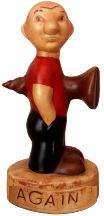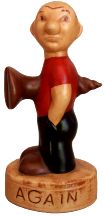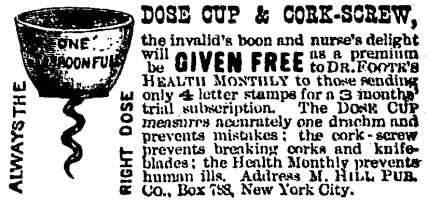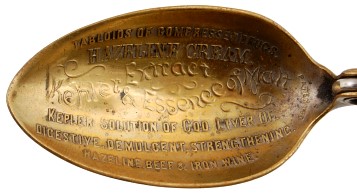 |
 The Virtual Corkscrew Museum's Weekly Newspaper |
 |
 |
 The Virtual Corkscrew Museum's Weekly Newspaper |
 |
|
Sunday, April 26, 2009 |
Number 554 |
Corkscrew and Spoon Holder
News from a 1905 issue of Hardware Dealers' Magazine:
A. M. Irby, Vernon Hill, Va., is placing on the market the Corkscrew and Spoon Holder illustrated. This little device is made of copper wire formed to shape. The object is to always have the spoon at hand when the contents of a bottle are to be used. The corkscrew, of course, is to be inserted in the cork and left until the bottle is emptied.
Addie Irby applied for a U. S. Patent on September 2, 1904. Patent No. 793,724 was issued on July 4, 1905. Addie wrote "As is well known in the use of medicines and the like, it is a source of inconvenience and oftentimes chagrin not to find a spoon handy and ready for use when it is desired to administer to the patient." The combination corkscrew and spoon holder was Addie's solution to the problem.
Addie placed this classified advertisement in the American Druggist and Pharmaceutical Record published by American Druggist Publishing Co. in 1906 "WANTED - To correspond with wholesale druggists' sundries salesman with an established trade to handle on commission a new an extremely useful household article - a corkscrew and spoonholder combined. Designed to draw corks from medicine bottles and hold spoon in suspension. Sells well on sight and yields good profit. The right man can have exclusive sales privilege in his territory. Address A. M. Irvy, Norfolk, Va." (interesting to note the ad showed the name as Irvy instead of Irby...ed).
Reader Paul Luchsinger (see news at end of this issue) hosted the 2008 meeting of the International Correspondence of Corkscrew Addicts (ICCA) in Williamsburg, Virginia. He scoured all of his corkscrew hunting grounds for the Irby patent without success. Not one to give up, however, the resourceful Luchsinger found someone to produce the corkscrew/spoon holder. To the delight of all attendees, he presented each with a medicine bottle complete with the modern Irby!
Dose Cups
John Henry Zeilin of Philadelphia, Pennsylvania, filed for a U. S. Patent for his "Dose-Cup Bottle-Stopper" on August 5, 1881. Patent number 254,760 was issued March 7, 1882. In his application, Zeilin wrote "Much inaccuracy in the measurement of family doses of medicine arises from the varying sizes of spoons by which they are usually administered." He says that his invention can be made to hold a "tea-spoonful, a dessert-spoonful, or a table-spoonful." Four variations of the dose cup are shown in the photograph. At left and right are tea-spoonful size and the two in the middle are a table-spoonful. The three silver cups on the left have the mark of S. Cottle & Company, New York, N. Y. (1877-1920).
From an advertisement by Mermod & Jaccard Jewelry Co. of St. Louis in the February 1894 issue of the Daughters of the American Revolution magazine American Monthly with World's Fair souvenirs. Mermod & Jaccard was founded in 1829 in St. Louis.

March 2, 1883 Advertisement from the Perry Chief (Iowa)
Who was J. H. Zeilin? This obituary from the 1897 American Druggist and Pharmaceutical Record tells his story.
John Henry Zeilin, the head of the firm of J. Henry Zeilin & Co., manufacturers and dealers in a number of well-known patent medicines, at No. 306 Cherry street, died on December 20th, at Clifton Heights, N. Y., where he had gone several weeks ago to recuperate his failing health. Mr. Zeilin was in his sixty-second year, having been born in Chester. Pa., in 1834. His boyhood days were spent in that town, and when he became old enough he was taught the drug business in the employ of the firm of John M. Maris & Co. at that time one of the largest houses in Philadelphia. Later on he went to Macón, Ga and afterwards bought out his employers, and in 1870 came back to Philadelphia once more. Because of his belief in the efficacy of printers' ink. his business prospered to such an extent that the present plant was occupied in 1883. Mr. Zeilin lived at 216 Tulpohocken street, Germantown, and four children survive him. Three daughters are married, and a son is not.
If you would like to learn more about Zeilin and the historic trademark suit brought by C. F. Simmons Medicine Company, click here.
Medicine Spoons
On June 12, 1882, Cornelius T. Williamson filed an application for his "Combined Spoon and Corkscrew." U. S. Patent No. 264,391 was issued September 12, 1882. This was followed by British Patent No. 18,819 issued on October 20,1892.
The spoon on the left has the mark of Currier & Roby, New York, N. Y. (1900-c.1943). The second spoon in the photograph is marked PATENTED and advertises "Tabloids of Compressed Drugs Hazeline Cream, Kepler Extract & Essence of Malt, Kepler Solution of Cod Liver Oil, Digestive, Demulcent, Strengthening, Hazeline, Beef & Iron Wine." The third spoon has the mark of George W. Shiebler & Co., New York, N. Y. (1876-1910). The table spoon on the right is marked STERLING without a maker's mark and it has a gold wash.

The bowl of the Burroughs, Wellcome spoon
Hazeline Cream and Kepler Extract were made in England by Burroughs, Wellcome & Co., Manufacturing Chemists. Wellcome was founded in London in 1880 by Henry Wellcome and Silas Burroughs. They established a branch in NY in 1906 and started a manufacturing laboratory in New York in 1908.
Burroughs, Welcome invented the name "Tabloid" and registered it as a trademark in England in 1884. The firm used the name on it's full range of products. Within a very short time, "Tabloid" became a household word and was used indiscriminately in reference to all types of tablets. By 1901 the term "Tabloid journalism" appeared and in 1918 small sheet newspapers were referred to as "Tabloids". Today a "Tabloid" is widely used for newspapers which are usually well illustrated and contain sensational material.
Bandy's Slug
Reader Jack Bandy submitted this photo of his "Dewey's Slug". Copy on the advertising plate is "Dewey's Slug/Two Fred's/59 So. Prairie St./Galesburg, ILL". We wonder if there was a "Dewey's Slug" corkscrew from Three Oaks, Michigan?
For the story on "Dewey's Slug", see the April 19 issue.
The German Wier - follow-up
Left: German; Right: English
In the April 12 issue we published a story from the July, 1887 issue of the American Druggist. Reader Reinhold Berndt submitted photos of the German Wier. He notes the big difference is in the size of the handle. Also note the web helix vs wire helix.
Submitted by Reinhold Berndt
Submitted by Reinhold Berndt
Wine Century Club
February 14, 2006 - The Wine Century Club of New York City is pleased to announce the formation of its first local chapter. The new chapter - WINE CELLAR 100 - is located in Williamsburg, VA and is sponsored by The Wine Seller in Monticello Marketplace.
Shown in the photograph are the first three members of the Williamsburg Chapter (from left, Bill Bean, VP, Heather Hatcher, President and Paul Luchsinger, Secretary). Luchsinger is shown holding a large corkscrew made from an elk antler. "It takes a big corkscrew to open all those bottles," joked Luchsinger, who boasts a large collection of unique and antique corkscrews. Currently there are eight members in this chapter, with meetings held at The Wine Seller.
Luchsinger writes: "How about mentioning the collection of grape varietals as in wine? I am involved in an active chapter of the Wine Century Club-- drink and record 100 different grape varietals found in wines. Wine Cellar 100 is the chapter for the Greater Historic Triangle Area - download your check list and get going (hint-moonshine is not a varietal). Check out the 'about' tab and you will see some info on the Williamsburg chapter with me holding a favorite large corkscrew. After all, when you have finished a busy day of collecting corkscrews, you can continue collecting varietals in the wine of the evening with the lady of the evening--no club yet for the latter!"
Notices
ICCAucions part 3a closes Sunday, April 26 and part 3b closes Sunday, May 3. There are total of 506 lots offered. Access here: http://www.auction.icca-corkscrew.com/
Preview Don Bull's auction listings at http://www.bullworks.net/iccauctions/2009aprmay1.htm.
In the May 7, 2007 issue we reported on Bob Roger's book Patented Ice Reducing Tools: An Identification Guide for Hand-Held Picks, Chippers, Crushers, and Shaves. In an earlier issue November 21, 2003, we reported on his book A Guide to Gimlets. Bob now has a new email address: toolman@edoppler.com.
|
©2009 Don Bull, Editor |